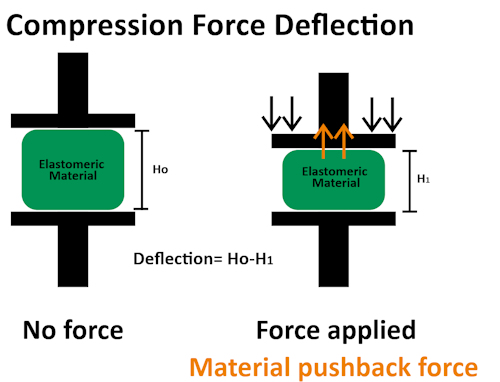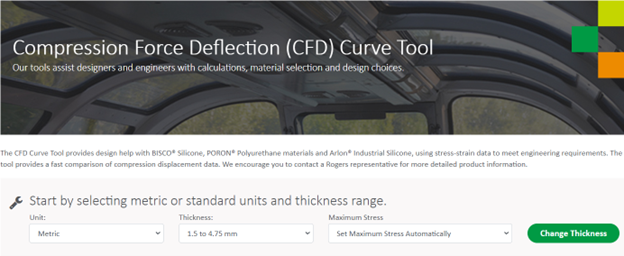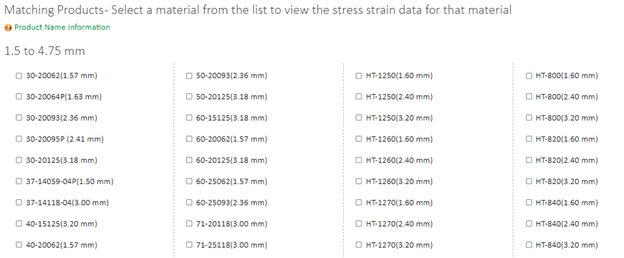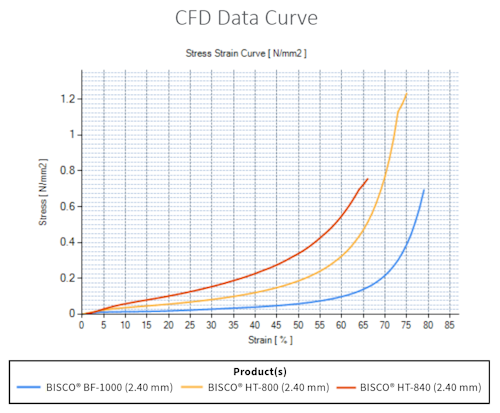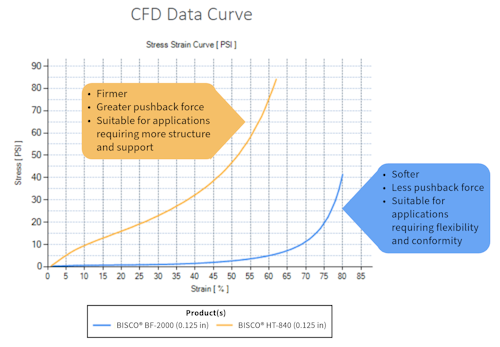
由罗杰斯公司发布
高弹体材料解决方案
在对密封和垫圈应用进行设计时,起关键作用的两个关键高弹体材料特性为压缩反弹应力和抗压缩形变。
这些特性通常出现在技术数据资料表 (TDS) 中,并对材料的缓冲、密封和隔振能力提供重要见解。了解这些因素如何影响材料性能,有助于确保可靠的密封性,尤其是在苛刻的环境中。
在本博客中,我们将重点介绍压缩反弹应力及其对应用设计的影响。请务必阅读到最后,我们提供了一个免费工具的教程,旨在帮助您做出更明智的设计决策。
什么是压缩反弹应力 (Compression Force Deflection)?
压缩反弹应力 (CFD),也称为压缩应变 (compression deflection) 或压缩力 (compression force),是一种测试方法,用于测量在试样上产生百分比 (%) 应变所需的力(换句话说,将材料压缩到其原始高度的某个百分比需要多大的力)。
让我们以一种简单的方式来分解这个概念:
- 压缩力是将材料挤压到其原始尺寸的一定百分比所需的力。对于技术数据资料表,大多数测试都是在 25% 的应变下完成的。
- 应变,记为 Ho-H1,是指从自由状态(未施加力)施加压缩力时材料高度降低的百分比。
下图描述了这一概念。
压缩应变表明材料在被压缩时提供反弹力的能力。这是一种简单的应力-应变关系,反映了材料在系统中反弹的力有多大。
为什么压缩应变在密封和其他应用设计中很重要?
压缩应变提供了对材料感觉、即时弹性和硬度的见解。对于大多数密封和垫圈应用,必须压缩高弹体材料以形成密封。了解材料在压缩下的反应情况是确保其满足您设计要求的关键。
例如,材料是否提供足够的反弹力来形成有效的密封?或者,反弹力是否过高,可能导致外壳变形?
这对于电动汽车 (EV) 中的汽车密封等任务关键型应用尤为重要,在这些应用中,外壳必须保护电池免受水和外部元件的影响。
应用示例:电动汽车 (EV) 电池密封以及压缩应变的重要性
在电动汽车 (EV) 电池密封应用中,底部外壳必须保护电池免受进水和外部元件的影响。正确的压缩量和反弹力对于在温度和机械应力等波动条件下防止泄漏和保持高性能非常重要。
如何测量压缩应变?
对于大多数泡棉和海绵材料,遵循 ASTM D1056 压缩应变测试。通常,对于泡棉或海绵材料,压缩应变通过将试样压缩 25% 来测量。这是泡棉和海绵材料技术数据资料表上报告的量,便于比较不同的材料。
密封中压缩应变的关键考虑因素
我们经常遇到提问:“什么是‘可接受的’压缩应变?”这取决于应用,但这里有一些关键考虑因素:
- 一般而言,建议的最小压缩率为 25% - 35%,因为设计工程师需要考虑材料、配合面和应力松弛的厚度公差。
- 允许从 50% 压缩至 70%,但在蜂窝材料中,可能导致蜂窝结构破裂。
- 垫圈高度、宽度和配合面
- 要密封防止进入的是什么?防尘?防水?防化学品?
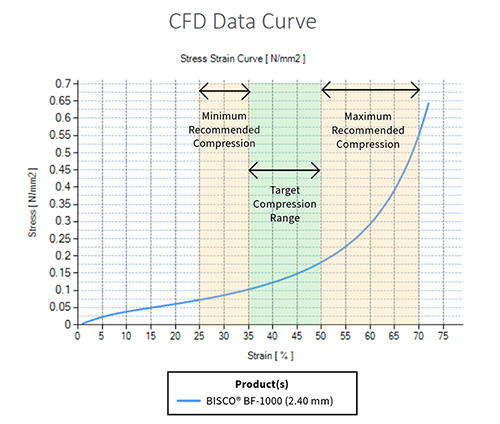
罗杰斯压缩反弹应力工具
罗杰斯提供压缩反弹应力工具,帮助您在 BISCO® 硅胶, PORON® 聚氨酯 和 ARLON® 工业硅胶产品组合中筛选出最适合的材料。该工具使用了 0% 至 80% 的应变范围内大量的应力-应变数据,从而能够更好地选择材料。
如何使用 CFD 工具:
首次打开工具时,您将看到以下屏幕:
- 选择单位、厚度范围和最大应力。将显示产品列表。
- 勾选要为其生成压缩应变曲线的材料。在本例中,使用厚度为 2.40 mm (0.094") 的 BISCO® BF-1000 超软、HT-800 中等硬度和 HT-840 特硬硅胶泡棉。注意:为了准确比较,选择相同的厚度非常重要。
- 该工具将自动生成压缩应变曲线。示例曲线如下所示:
压缩应变曲线说明了什么?
压缩应变曲线显示施加的力与材料应变之间的关系。从上面的曲线可以看出,应变与泡棉上的作用力之间的关系不是线性的。泡棉或海绵材料最初不易压缩,因为最开始压缩的是蜂窝结构中的空气孔隙。但是,随着压力的增加,曲线将在某个点开始迅速上升。这是由于材料蜂窝结构塌陷并被压缩。此时,材料的表现更像固体产品。(阅读更多关于泡棉、海绵和固体特性的信息)。
材料曲线越靠右,表示其越柔软。
在上述例子中,我们可以看到 BISCO® BF-1000 最柔软,BISCO® HT-800 中等硬度,而 BISCO® HT-840 最坚硬(三者厚度相同)。
为什么这对应用设计很重要?
压缩应变值较高的材料更坚硬,反弹力也更大,使其适用于需要更多结构和支撑的应用。另一方面,压缩力值较低的材料更柔软贴合,非常适合需要柔韧性和贴合不规则表面的应用,这有助于吸收配合材料的厚度公差。
为什么罗杰斯使用压缩应变代替邵氏 OO 硬度?
邵氏 OO 硬度仅测量泡棉表面的单个局部点,这并不能准确代表整个材料的整体硬度。它主要测量材料表面的凹陷程度,包括 x-y 延伸和垂直(z 轴)压缩。这使其更适合评估表面的强度而不是完整的材料性能。
相比之下,压缩应变测量较大面积材料样品的平均硬度。这样可以更全面地了解材料在现实条件下的性能。通过使用压缩应变,设计人员可以根据材料承受压缩的能力对材料适用性做出更准确的决策,从而确保特定应用中的可靠性能。
要点
压缩反弹应力测量的是将高弹体材料压缩指定的距离所需的力(换言之,泡棉回弹多少力,即反弹力),从而深入了解其缓冲、密封和隔振能力。
使用罗杰斯压缩反弹应力工具快速比较材料并确定适合您应用的材料,立即开始优化您的设计,以获得更好的密封和性能。
有关更多信息,请联系罗杰斯销售工程师。
相关内容
相关产品:
PORON 工业聚氨酯、BISCO 硅胶、Arlon 硅胶
发布于 2024 年 11 月 12 日
